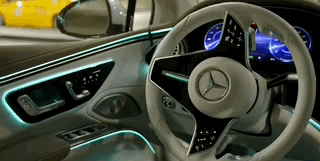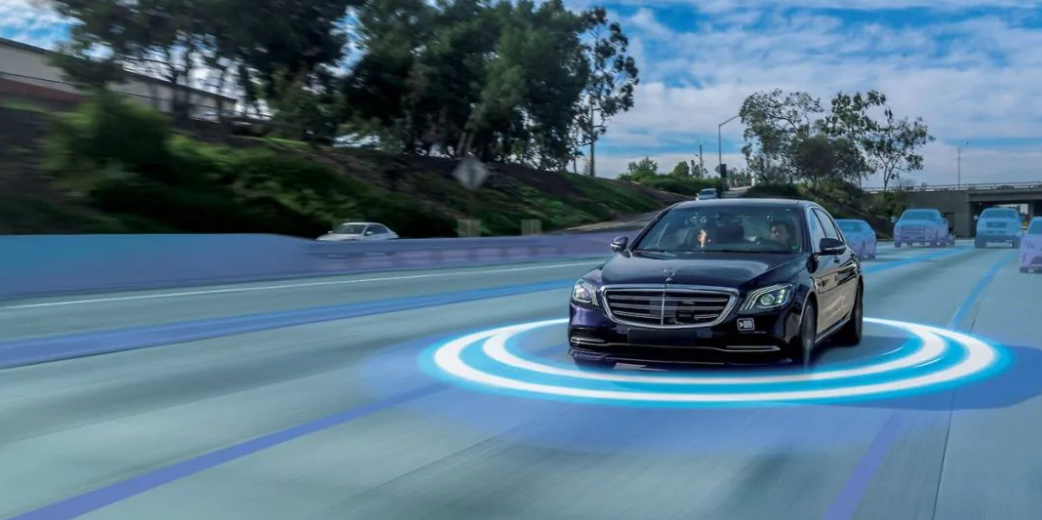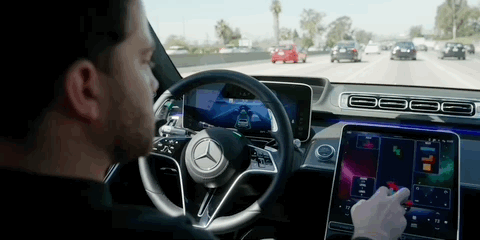Wanbo, posted from Vice Driving Temple
Reference to Intelligent Driving | WeChat public account AI4Auto
Mercedes-Benz, a veteran automaker, has made a decision that other car companies dare not make:
If a user has an accident while using Mercedes’ Drive Pilot autonomous driving system, Mercedes will take full responsibility.
Before this decision, whoever and whoever were all marketing “autonomous driving” as “assisted driving”. In the end, the conclusion was the same–the car owner did not use it properly and did not take over in time.
But why is Mercedes daring to make such a firm statement? What level is its Drive Pilot autonomous driving system? What is its performance like?
Mercedes’ production cars equipped with Drive Pilot have already started small-scale promotion and testing. Let’s take a look at the most direct feedback together.
What is the Drive Pilot all about?
Mercedes officially defines this Drive Pilot as an L3-level autonomous driving system. It is installed on Mercedes’ latest luxury pure electric sedan EQS, priced between 1 million and 1.5 million RMB.
Not long ago, it was also officially endorsed and recognized by the European Economic Committee as the first and only L3-level autonomous driving system. It’s even better than Tesla’s FSD.
But no matter how much endorsement is received, it’s always important to let the performance speak for itself. While announcing the responsibility of the system, Mercedes also invited third-party road testers to experience the Drive Pilot with the following details:
The Mercedes Drive Pilot allows for hands-off driving. Simply start the system by taking over the steering wheel, and the green light lights up, and you can go completely hands-free:
The vehicle smoothly starts and stops in congested sections, maintaining a distance that is further than what humans could do:
Even when there are fast-moving vehicles nearby, it can avoid in time:
When there are vehicles cutting in ahead, it pre-decelerates:
What if the driver gets bored? How about… playing Tetris on the car’s infotainment screen?
In general, the performance is indeed very confident, but in the video, Drive Pilot only demonstrated a small part of the ACC adaptive cruise control function. Other L3-level autonomous driving standard equipped features such as automatic lane change, on-off ramp driving, and more were not shown.
In addition to this, Mercedes-Benz even directly upgraded the Drive Pilot automatic parking function to level L4, reportedly making it possible to achieve fully unmanned automatic parking in scenarios including automatic parking spot search, route planning, and automatic shut-off. All of these functions have already been implemented in production cars.

However, there are two key factors that have enabled Mercedes-Benz and European official organizations to recognize L3-level autonomous driving:
First, control attribution.
Drive Pilot allows the driver to free up their hands while not requiring the driver to concentrate their attention. The portion of the video showcasing the driver playing Tetris demonstrates this point.
In the world’s major autonomous driving level standard, having the automatic driving system completely take over the vehicle is a necessary condition for the division of auxiliary driving and L3 and above autonomous driving.
Second, attribution of rights and responsibilities.
There is currently no unified and clear legal boundary for accident rights and responsibilities of autonomous driving around the world. However, the industry generally believes that the main responsibility for Level L2 auxiliary driving should belong to individuals, while the subject of responsibility for L3 and above autonomous driving should be borne by enterprises.
For example, in China, for all high-level autonomous driving test projects, enterprises are required to bear all responsibility in the event of an accident.
From these two perspectives, Mercedes-Benz’s Drive Pilot does indeed meet the L3-level autonomous driving standard.
However, it is worth pausing here to note that the Drive Pilot autonomous driving system is still conditional.

Drive Pilot cannot be used if the vehicle’s speed exceeds 40 mph (60 km/h) or if high-precision maps are not available, or in adverse weather conditions (such as rainy or snowy weather), except for high-speed congested road sections.
This also meets the autonomous driving division standard for L3-level limitations.
Regardless of which perspective is considered, Mercedes-Benz’s L3-level autonomous driving system is indeed worthy of its name.And, as the first mass-produced Level 3 autonomous driving system recognized by both the automaker and official authorities among all global automakers, Mercedes-Benz has done something that no other player has dared to do.
However, in terms of capability, Mercedes-Benz’s Level 3 autonomous driving system is still a far cry from the intelligent driving systems of leading automakers in the market.
After all, players such as Tesla, XPeng, and traditional automakers like Great Wall have already begun to push their Drive Pilot systems for high-speed autonomous driving since the second half of last year (and with less restrictions).
Even in open road scenarios within the city, these players have started testing their systems and, whether or not they choose to push forward, they may still face regulatory issues at the moment.
Pressure is now on the Drive Pilot system. If it cannot be updated and iterated quickly in the future, it is destined to be a production lag.
Not to mention that the Drive Pilot system can only be used within a range of 8,000 miles (12,800 kilometers) in Germany at present, and is still in testing phase in the United States.
Furthermore, Drive Pilot is also facing regulatory thresholds in markets outside Europe, and there is still a lot of uncertainty in North America and China.
However, ultimately Drive Pilot is still the world’s first Level 3 calibrated autonomous driving system, and it was a traditional automaker, Mercedes-Benz, that took the first step.
Therefore, perhaps the greater significance lies in Mercedes-Benz’s determination to indicate its transition towards intelligence.
How is Mercedes-Benz’s transition towards smart transformation?
Among traditional automakers, who has the fastest pace of smart and electrification transformation? There is no unanimous answer.
However, Mercedes-Benz has the most aggressive transformation plan when it comes to transition towards intelligence.
Mercedes-Benz’s smart transformation mainly includes three parts, in addition to the autonomous driving system discussed above: intelligent cockpit and electronic architecture.
Regarding the intelligent cockpit, Mercedes-Benz has developed a proprietary system, the MBUX Hyperscreen, which is the first to be equipped on the EQS.
The computing platform uses NVIDIA Xavier AI chips and is equipped with an 8-core CPU, 24GB of memory, and 46.4GB of memory bandwidth per second.On the functional side, the official claim from Mercedes-Benz is that it is “zero-level”. In addition to displaying all high-frequency functions in the main interface, other functions will also be automatically displayed on the interface as needed by the on-board AI system. The intelligent cabin AI can self-learn and evolve, and can prompt and push functions such as seat heating and air conditioning based on the driver’s usage habits.
In terms of electrical architecture, Mercedes-Benz’s solutions are more closely related to its vast matrix of electric vehicle products.
Currently, Mercedes-Benz’s latest pure electric vehicle, the EQS, uses Mercedes-Benz’s first-generation pure electric platform EVA, which is mainly responsible for completing the electrification transition of existing Mercedes-Benz main models, including the famous E-Class and S-Class.
By 2025, Mercedes-Benz’s second generation of three pure electric platforms will be launched successively.
Among them, the MB.EA platform is mainly used to replace EVA and MRA platforms, responsible for the development of all mid-to-large size passenger car products of Mercedes-Benz, and the AMG.EA is an exclusive platform for performance electric vehicles. The VAN.EA pure electric architecture platform is used for pure electric MPVs and light commercial vehicles.
According to official information, these three pure electric platforms will all adopt modular design, but whether they will evolve towards central processor architecture, Mercedes-Benz has not disclosed, but currently the entire industry’s mainstream solution for meeting the requirements of automotive intelligence is to transition to central computing platform architecture.
If Mercedes-Benz wants to make progress in the transformation towards automotive intelligence, a centralized architecture design is almost the only choice.
In addition to its vast product plans, Mercedes-Benz’s substantial investment in intelligent electrification also shows its determination:
From this year to 2030, investment in intelligent electric vehicles will exceed 40 billion euros (approximately RMB 279.2 billion), with main investments in the three areas of power electronics, automatic driving, and digital cockpit.
Under this, Mercedes-Benz expects that the sales of new energy vehicle models will account for more than 50% by 2025, and achieve comprehensive electrification by 2030.
This whole transformation plan is also seen by the outside world as the most radical plan among traditional automakers.
At the macro level, this is roughly the situation.
As for Mercedes-Benz’s debut work in intelligent transformation, the Drive Pilot intelligent driving system equipped on EQS is Level 3 autonomous driving right from the start.To know that Tesla’s FSD system at L5 level, as mentioned by Musk, was only submitted as an official document at L2 level in court.
From this perspective, Mercedes-Benz is the representative of the most advanced intelligent car.
Also from this perspective, the Mercedes EQS starting from 1 million yuan is not expensive, right? (manual dog head)
Road test video link:
https://www.youtube.com/watch?v=rf_ufPjpMCw
—End—
This article is a translation by ChatGPT of a Chinese report from 42HOW. If you have any questions about it, please email bd@42how.com.






